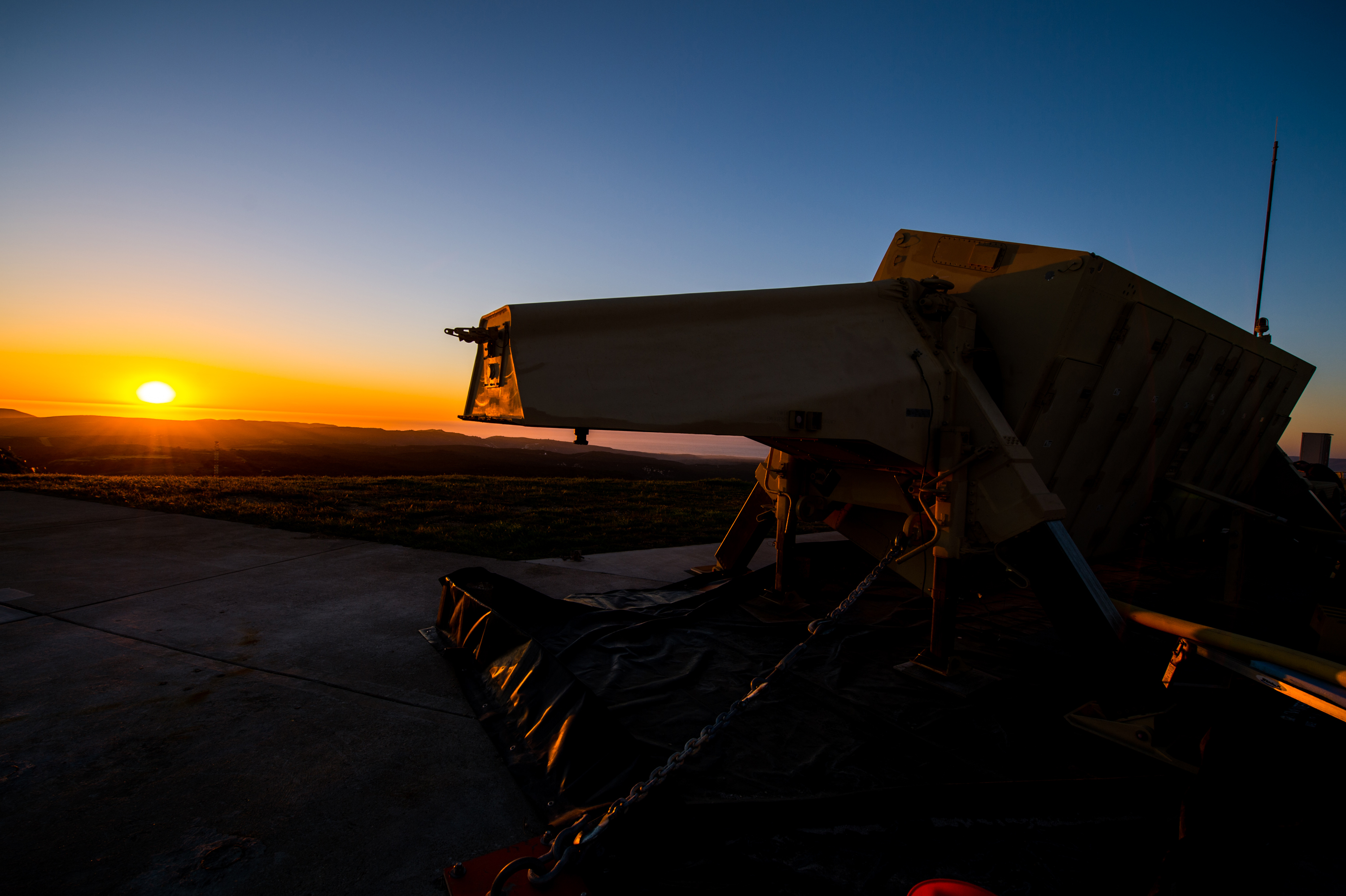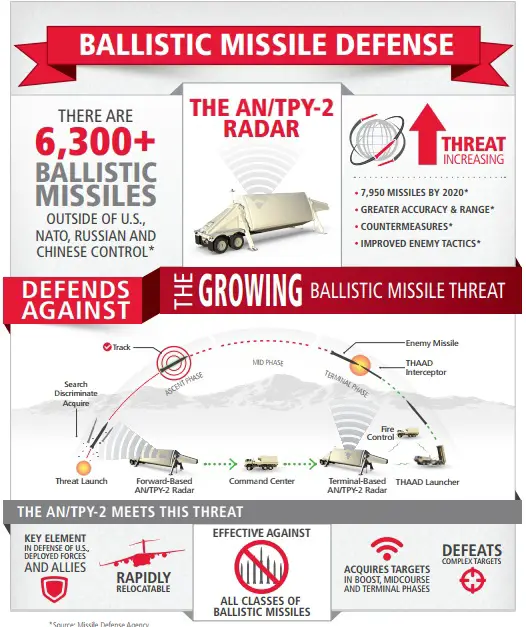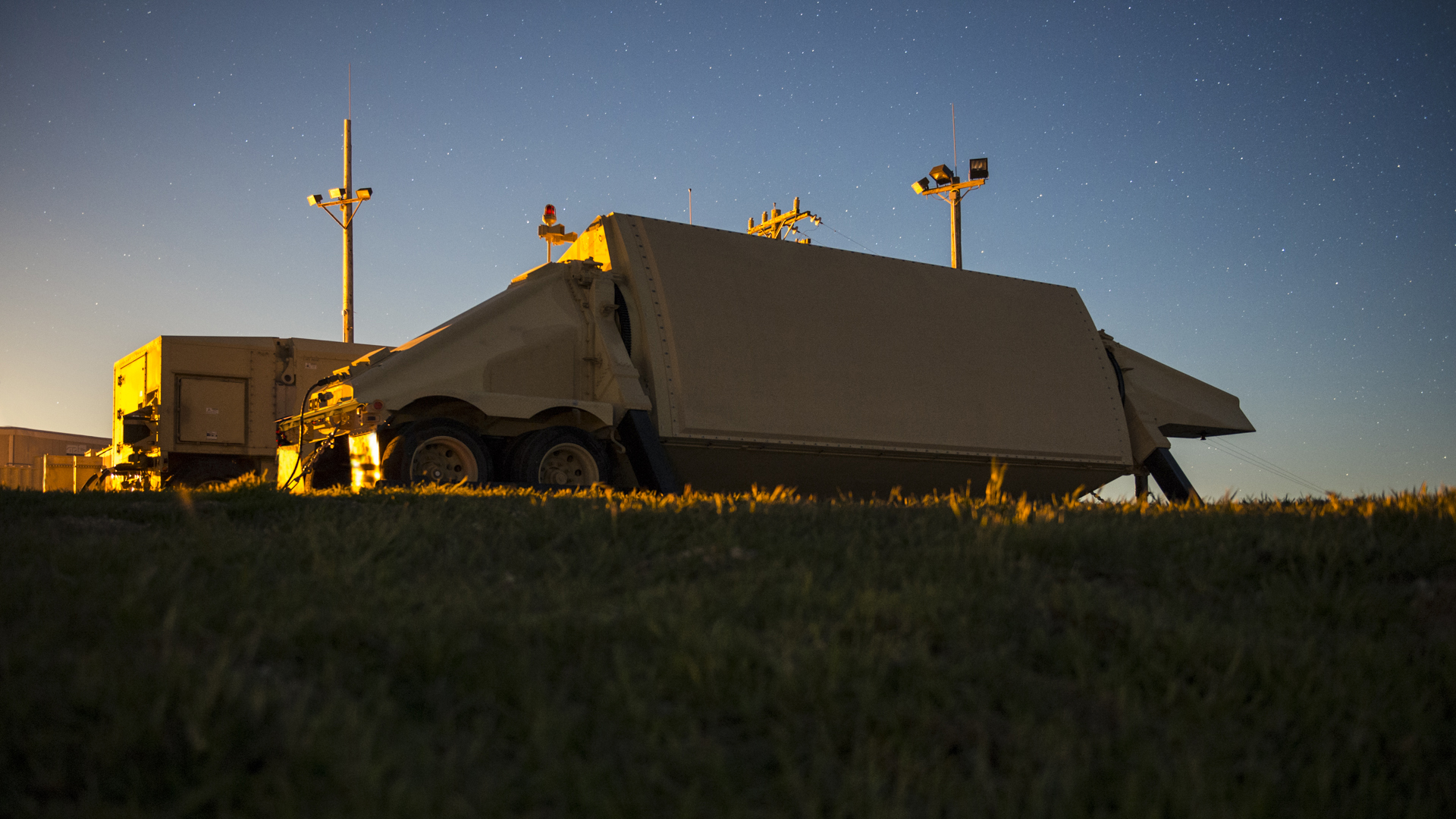The AN/TPY-2 Surveillance Transportable Radar, also called the Forward Based X-Band Transportable (FBX-T) is a long-range, high-altitude active electronically scanned array surveillance radar designed to add a tier to existing missile and air defense systems.[3] Made by Raytheon, it is the primary radar for the Terminal High Altitude Area Defense missile system, but also cues the AN/MPQ-53 radar of the MIM-104 Patriot system. Patriot PAC-3 is a lower-altitude missile and aircraft defense system than THAAD.
The AN/TPY-2 is a missile-defense radar that can detect, classify and track ballistic missiles. It operates in the X band of the electromagnetic spectrum, which enables it to see targets more clearly, and it has two modes – one to detect ballistic missiles as they rise, and another that can guide interceptors toward a descending warhead. The radar meets the need of the United States and its allies for proven, affordable defense to keep pace with the world’s ballistic missile threat. There are more than 6,300 ballistic missiles outside the control of the United States, NATO, Russia and China, according to public U.S. intelligence estimates, and rogue regimes are proliferating and improving nuclear, chemical and biological weapons.

The first step in defeating a ballistic missile that has been fired is “seeing” it. And that’s where Raytheon’s AN/TPY-2 X-Band radar comes in. A critical element in the Ballistic Missile Defense System, AN/TPY-2 continually searches the sky for ballistic missiles. Once it detects a missile, it acquires it, tracks it, and uses its powerful radar and complex computer algorithms to discriminate between the warhead and non-threats such as countermeasures.
Depending on the needs of the warfighter, the AN/TPY-2 radar can be deployed in two different modes. In forward-based mode, the radar is positioned near hostile territory, and acquires ballistic missiles in the boost (ascent) phase of flight, shortly after they are launched. It then tracks and discriminates the threat, and passes critical information required by decision makers to the Command and Control Battle Management network.
When the AN/TPY-2 radar is deployed in terminal mode, the radar’s job is to detect, acquire, track and discriminate ballistic missiles in the terminal (descent) phase of flight. The terminal-mode AN/TPY-2 also leads the Terminal High Altitude Area Defense ballistic missile defense system by guiding the THAAD missile to intercept a threat.

AN/TPY-2 has a record of flawless performance against all classes of ballistic missiles. In forward-based mode, it has proven capability against short-, medium and intermediate-range ballistic missiles. In terminal mode, AN/TPY-2 has demonstrated its ability to enable an intercept of short- and medium-range ballistic missiles.
Raytheon has delivered ten AN/TPY-2s to date, and is in the process of building two more for the U.S. customer, and two for international partners. These radars are an important step in the right direction to meeting the growing U.S. and international demand for an affordable, proven system that can stay ahead of the increasing ballistic missile threat.
The U.S. Army developed it and remains responsible for its use by air defense artillery in theater and tactical applications. As a component of national ballistic missile defense, the U.S. Missile Defense Agency is responsible for AN/TPY-2 applications.
It has been deployed in Japan to collect strategic-level information on North Korean missile developments, as well as warning Japan of incoming warheads. Japan has bought both PAC-3 for point defense, and is upgrading the AEGIS systems on its Kongo-class destroyers so they can use the longer-range RIM-161 Standard SM-3 theater ballistic missile defense.
An AN/TPY-2 is based in Alaska as part of United States national missile defense development. The U.S. has agreed to provide it to Israel, to complement their two-tier Arrow 2 missile and Patriot PAC-3 missile defense.
The AN/TPY-2 is a phased-array radar, which operates in the 8.55–10 GHz X band. Raytheon builds it as part of an X-band family, along with the National Missile Defense (NMD) X-Band Radar (XBR) and AN/FPS-129 HAVE STARE.
It complements the fixed AN/FPS-129 HAVE STARE X-Band “large dish” radar, located at Vandenberg Air Force Base. Smaller mobile X-band dishes, not yet designated, may also be paired with the AN/TPY-2.
AN/TPY-2 Army Navy/Transportable Radar Surveillance

AN/TPY-2 Army Navy/Transportable Radar Surveillance